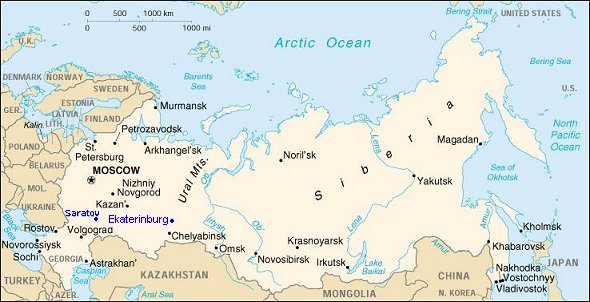|
Subject: Ekaterinburg
Public Hearing June 2, 2000
From: Lou Zeller
Place: Ekaterinburg
Date: Friday, June 2
We are east of the
Urals Mountains and at a very northern
latitude. The sky is bright at 11 PM.
Today the American
Delegation attended the Public Hearing at Dom
Tekniki (House of Technology) in
Ekaterinburg. The hearings was organized by
Leonid Piskunov, a retired physicist who is very
active in the movement to stop plutonium fuel in
his home town, and Anatol Lebedev, President of
the Urals Environmental Union which is
a regional organization of scientists and
lawyers.
The proceedings began
with a speech by Janet Zeller on environmental
justice, environmental democracy, and community
control. She said, "We oppose
plutonium fuel in nuclear power reactors because
it is expensive and endangers public
health. And the state program to use this
fuel violates democratic rights."
Lydia Popova, a
former Minatom nuclear physicist who now leads
the Socioecological Union which opposes plutonium
fuel, spoke about this magnificent Ural Mountain
region and of her sadness that the
Chelyabinsk accident contaminated this land of
Russian fairy tales with poisonous tritium,
cesium, and other radionuclides. She said,
"This is a Cold War technology which was
invented for the production of military
plutonium. Now Minatom proposes to use its
failed reactors for plutonium fuel. But the
politicians never consulted the
people. Do we really need to use this Cold
War legacy. It is a dead end!" Other speakers gave
talks with detailed information about the 1957
explosion at Chelyabinsk and the
radioactivity which still contaminates the
Techa River and the lands around it.
Families which suffer from birth defects caused
by the damage have still not been compensated.
Leonid Piskunov rose
to tell of the 1987 accident at Beloyarsk Nuclear
Power Plant. The accident reached the
fourth level of seriousness, the
fallout was 1 Curie per square kilometer, and
release of radioactivity continues. In 1988
the plant secretly began using plutonium
fuel. He spoke about the lack of
containment at the BN-600 reactors and said,
"Nuclear facilities do not comply with
regulations."
Following the
hearing, the participants took action and
supported in principle a comprehensive position
which includes a public environmental impact
statement, a formal licensing process
for plutonium fuel use, and the
establishment of a research center for radiation
dose impacts.
Attachment--Photo of
the hearing with Janet Zeller addressing the
assembly. Leonid Piskunov, who chaired the
meeting, is seated next to the
speaker's podium. On the far right is
Fran Macy, of the Berkeley-based Center for Safe
Energy, who heads the American Delegation.
|







